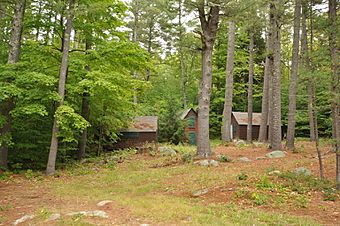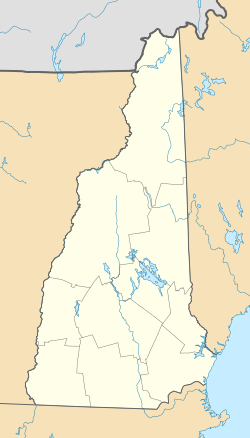Abenaki Indian Shop and Camp facts for kids
|
Abenaki Indian Shop and Camp
|
|

Some of the cabins
|
|
| Location | Intervale Crossroad, 1 mi. E of NH 16, Conway, New Hampshire |
|---|---|
| Area | 3.8 acres (1.5 ha) |
| Built | 1884 |
| Architect | Joseph Laurent |
| NRHP reference No. | 91000218 |
Quick facts for kids Significant dates |
|
| Added to NRHP | February 28, 1991 |
The Abenaki Indian Shop and Camp is a special historical place in Conway, New Hampshire. It was once a camp where Abenaki people lived and worked. They came here to make and sell beautiful baskets and other crafts. Tourists visiting the White Mountains in the late 1800s loved to buy these items.
This site was active for many years, even into the late 1900s. It is now recognized as an important historical spot. It was added to the National Register of Historic Places in 1991. It is also on the New Hampshire State Register of Historic Places. Today, you can find it on Intervale Cross Road, and it is a public park.
Contents
What is the Abenaki Indian Shop and Camp?
The Abenaki Indian Shop and Camp is located in Intervale. It sits on the north side of Intervale Cross Road. The Conway Scenic Railroad tracks run between the road and the site.
Exploring the Historic Site
The area covers about 3.8 acres (about 1.5 hectares). Much of this land is covered with trees. At the southern end, there is a small wooden building. It has a pointed roof and a special plaque that tells about the site's history. A short distance north of this building, you will find several small cabins. These cabins also have pointed roofs and are covered with wooden shingles. They are grouped around a small open space in the woods.
Who Started the Abenaki Camp?
The Abenaki camp was started by Chief Joseph Laurent. He was an important leader of the Abenaki people from Odanak in Quebec, Canada. In 1884, Chief Laurent came to this area. He set up a camp that was used during certain seasons of the year. The land for the camp was owned by a local hotel at that time.
Why Was the Camp Important?
Chief Laurent and other Abenaki people made baskets and other handmade items at the camp. They sold these crafts to the hotel guests. This was a way for the Abenaki to share their culture and earn a living. The Abenaki people are descendants of the original Native Americans who lived in this region long ago.
The main shop building was originally a shed. It was built by the Maine Central Railroad. Chief Laurent bought this shed around 1900. He is also known for building the small cottages where the Abenaki families lived.
The Camp's Legacy Today
Chief Laurent's son, Stephen Laurent, continued the family business. He kept the camp running into the late 20th century. Since 1985, the town has owned this special property. They now manage it as a small park. There are signs at the park that explain its interesting history.



